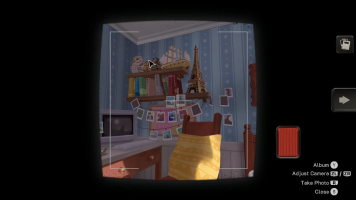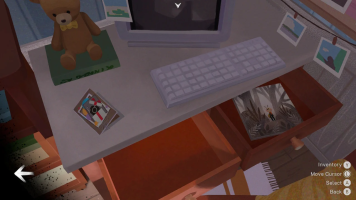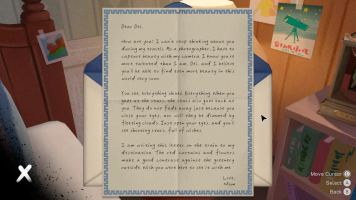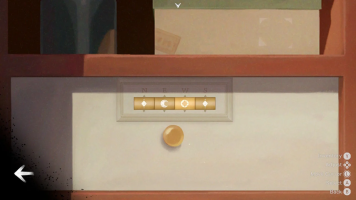Official Review
For this review's sake, please think about that metaphor, because it's the premise of The Star Named EOS. Silver Lining Studio and PLAYISM have delivered a puzzler built into an emotional narrative. And, like a photo, this game is just a brief snapshot, yet it manages to tell an in-depth story.
In The Star Named EOS, you control Dei and view the world from a first-person perspective. The game is organised in chapters, each in a different location – from Dei's childhood bedroom, to a train, to a café – as he traverses back through his memories. Each chapter begins with his mother's voice reading out a letter. She always includes a sweet sentiment tinged with sadness, like '[stars] do not fade away just because you close your eyes'.
Silver Lining masterfully inject nostalgia into every scene – no easy feat when the player hasn't been here before. Dei's childhood bedroom is filled with peeling posters and well-loved picture books. The café is home to half-sipped coffee and chairs askew. These scenes have stories to tell. And the story shines, depicting Dei's relationship with his mother alongside topics of memory, trauma and belonging. Everything is wrapped in an astrologically-themed narrative that shifts as you play. Now, if that description sounds vague, that's because we're trying to provide a snapshot while cropping out the spoilers. We will say this, though: the love between mother and son warmed our hearts, and, at the apex of the plot, we had tears, and stars, in our eyes.
You'll no doubt have encountered in-game photography countless times before, but in The Star Named EOS, it's the main function. Dei's relationship with his mother is marked by a shared love of photography, and she's even passed down her old Polaroid camera to him. As Dei, your primary task is to recreate your mother's photos. For your first photo, you need a rose and curtains. Besides a quick camera tutorial, you won't get many hints, and are left to your own devices, but not in a way that feels distant. It prefers to decorate the space with clues. As you feel your way around the room, you find a torn page tucked inside a scrapbook. This fits in an old children's book which, when pieced together, helps you unlock a box, and so on. This is the kind of visual storytelling and breadcrumb-dropping that will thrill fans of Botany Manor and Unpacking.
The plot is layered with clever, visually-led puzzles that give your brain a good tickle These include mazes, jigsaws and sliding puzzles that engage with their surroundings, and the mechanics play with gravity and movement, making effective use of your in-game camera. Every puzzle gives you just enough of a snippet to chronicle the events of each photograph without overexposing anything, and it feels satisfying when the pieces align.
You'll use maths, logic, memory, and deductive skills throughout, so we kept a pen and paper handy to document the many symbols and clues scattered about, and we always managed to reach the answer before the point of frustration. We also couldn't remember how we solved most puzzles and even completed one as a fluke. Then, after beating the game, we wanted to play through it again to work backwards and understand how we'd done it.
There's a lovely connectedness of using items or clues you get throughout the game; one early clue you find in the bedroom can be used later in the café, for example. You're also rewarded for your curiosity when you capture interesting objects that might be outside the main story, with special borders you can apply to photos that provide a slice of narrative to go along with them. It ensures that even though the locations may be disparate, the world is cohesive and everything is linked.
The Star Named EOS' seven-hour runtime is short, but the slow, relaxed nature of the game means that finding clues provides a little flash of excitement. It's far from boring, and we found ourselves content to swivel our scope around the various scenes, eyeing the aesthetic, chapter after chapter.
That's because The Star Named EOS's visuals absolutely sparkle. The hand-drawn art style, soft textures and warm lighting make for a homey atmosphere that feels cozy to look at. Seriously, look at these screenshots! We would've loved to include other stunning scenes but they're beyond spoiler point, so you will have to play to see them yourself.
The poignant, acoustic music and slow tempos perfectly harmonize with the game's soothing vibe. You're prompted to wear headphones when you start and we agree that doing this offers an intimacy akin to receiving a letter. The audio experience is still excellent with speakers, however – either from your TV or the Switch itself in handheld.
As with photography in real life, the mechanics can be a bit tricky on Switch. It seems like the game was made with PC top of mind, and it's calling out for a mouse. The amount of click-and-drag is a bit of a drag when you have to hold 'A' and jiggle the joystick. Items snap to certain positions but they aren't always precise, and while the touchscreen capability helps a little, it's less responsive than we would have liked. And it doesn't use the Switch's gyroscope function, which is a shame for all the point-of-view exploration.
Conclusion
Like a photo, The Star Named EOS is a fleeting moment in time. During its all-too-short playthrough, the game gives us so much to love: between the art, the story, and the puzzles, we can't choose just one highlight. And once the credits rolled we already wanted to take another turn. Puzzle games don't have the best replay value, but we would be delighted to return to this one thanks to the tricksy teasers and compelling mother-son narrative. There's not much more to say here — a photo is worth a thousand words.





